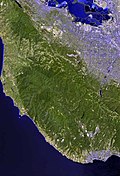| Llagas Creek | |
|---|---|
 Llagas Creek near Oak Glen Avenue, March 2017 | |
 | |
| Location | |
| Country | United States |
| State | California |
| Region | Santa Clara County |
| City | Gilroy, California |
| Physical characteristics | |
| Source | On the eastern flank of Crystal Peak in the Santa Cruz Mountains |
| • coordinates | 37°06′59″N121°50′02″W / 37.11639°N 121.83389°W [1] |
| • elevation | 3,360 ft (1,020 m) |
| Mouth | Confluence with Pajaro River just after passing through Lower Miller Slough |
• coordinates | 36°57′50″N121°30′28″W / 36.96389°N 121.50778°W [1] |
• elevation | 141 ft (43 m) [1] |
| Basin features | |
| Tributaries | |
| • left | Twin Falls Creek, Baldy Ryan Canyon, Heron Creek, Tilton Creek, Paradise Creek, East Little Llagas Creek, Church Creek, Skillet Creek, Panther Creek, Live Oak Creek, Alamias Creek |
| • right | Cañada Garcia Creek, Machado Creek, Hayes Creek, Lions Creek, Princevalle Drain |
Llagas Creek is a perennial stream in Santa Clara County, California, United States. [2] The headwaters rise on the eastern side of Crystal Peak near Loma Prieta. From there, the creek flows northeast along Casa Loma Road, until it reaches Uvas Road, and then turns south. At Oak Glen Avenue, the creek turns southeast, passing through Chesbro Reservoir, and the cities of Morgan Hill, San Martin, and Gilroy. The creek continues its southward flow, eventually joining with the Pajaro River at the San Benito County line.
Contents
The lower Llagas Creek, south of Gilroy, passes through a system of percolation ponds (Lower Miller Slough) which are used to treat wastewater in the area. [3] [4] [5]
